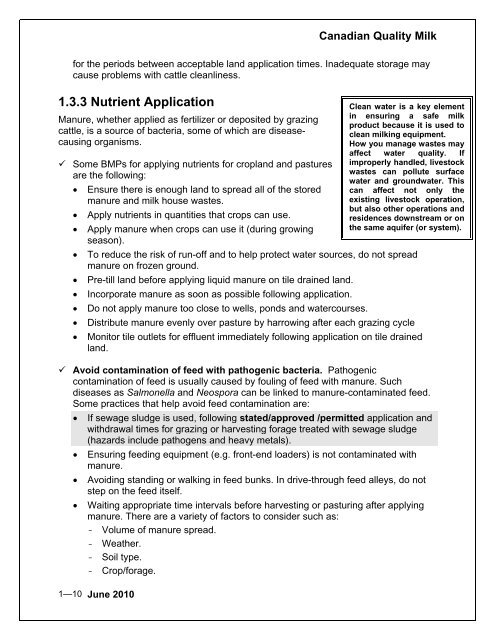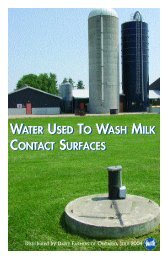Canadian Quality Milk On-Farm Food Safety Program - Centre ...
Canadian Quality Milk On-Farm Food Safety Program - Centre ...
Canadian Quality Milk On-Farm Food Safety Program - Centre ...
Create successful ePaper yourself
Turn your PDF publications into a flip-book with our unique Google optimized e-Paper software.
<strong>Canadian</strong> <strong>Quality</strong> <strong>Milk</strong><br />
for the periods between acceptable land application times. Inadequate storage may<br />
cause problems with cattle cleanliness.<br />
1.3.3 Nutrient Application<br />
Manure, whether applied as fertilizer or deposited by grazing<br />
cattle, is a source of bacteria, some of which are diseasecausing<br />
organisms.<br />
Some BMPs for applying nutrients for cropland and pastures<br />
are the following:<br />
• Ensure there is enough land to spread all of the stored<br />
manure and milk house wastes.<br />
• Apply nutrients in quantities that crops can use.<br />
• Apply manure when crops can use it (during growing<br />
season).<br />
Clean water is a key element<br />
in ensuring a safe milk<br />
product because it is used to<br />
clean milking equipment.<br />
How you manage wastes may<br />
affect water quality. If<br />
improperly handled, livestock<br />
wastes can pollute surface<br />
water and groundwater. This<br />
can affect not only the<br />
existing livestock operation,<br />
but also other operations and<br />
residences downstream or on<br />
the same aquifer (or system).<br />
• To reduce the risk of run-off and to help protect water sources, do not spread<br />
manure on frozen ground.<br />
• Pre-till land before applying liquid manure on tile drained land.<br />
• Incorporate manure as soon as possible following application.<br />
• Do not apply manure too close to wells, ponds and watercourses.<br />
• Distribute manure evenly over pasture by harrowing after each grazing cycle<br />
• Monitor tile outlets for effluent immediately following application on tile drained<br />
land.<br />
Avoid contamination of feed with pathogenic bacteria. Pathogenic<br />
contamination of feed is usually caused by fouling of feed with manure. Such<br />
diseases as Salmonella and Neospora can be linked to manure-contaminated feed.<br />
Some practices that help avoid feed contamination are:<br />
• If sewage sludge is used, following stated/approved /permitted application and<br />
withdrawal times for grazing or harvesting forage treated with sewage sludge<br />
(hazards include pathogens and heavy metals).<br />
• Ensuring feeding equipment (e.g. front-end loaders) is not contaminated with<br />
manure.<br />
• Avoiding standing or walking in feed bunks. In drive-through feed alleys, do not<br />
step on the feed itself.<br />
• Waiting appropriate time intervals before harvesting or pasturing after applying<br />
manure. There are a variety of factors to consider such as:<br />
- Volume of manure spread.<br />
- Weather.<br />
- Soil type.<br />
- Crop/forage.<br />
1—10<br />
June 2010
















